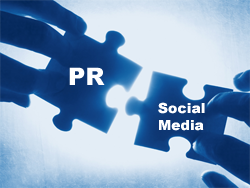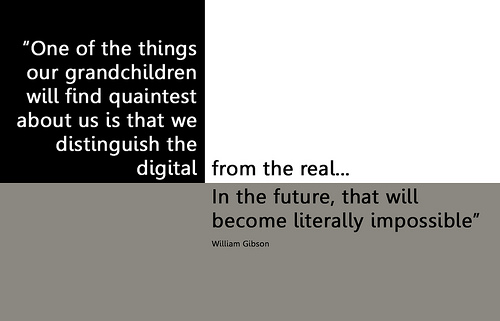 Recently, I presented at PubCon on the intersection of social media and PR. The session title was “experts on PR and Twitter,” however the session description went on to discuss a variety of networks. Therefore my interpretation was to speak on the intersection of social media and PR, and not just PR and Twitter.
Recently, I presented at PubCon on the intersection of social media and PR. The session title was “experts on PR and Twitter,” however the session description went on to discuss a variety of networks. Therefore my interpretation was to speak on the intersection of social media and PR, and not just PR and Twitter.
The social web is far more than just Twitter, and if Twitter is the extent of your participation you’re missing out. Lee’s diagram of social media and channels of distribution presents a visualization of a strong approach, where the centerpiece is a blog. The centerpiece could be anything of course, not just a blog – but the essential element is that it’s a place you control and not an external network. Using Twitter or any network you don’t control as the centerpiece is a mistake, because you’re building the value of a digital asset that isn’t really yours (no analytics, no control, no SEO benefit and if that network falls out of favor all your hard work is devalued).
Additionally, while today we speak about channel-specific PR or marketing, the future will be different. Traditional and digital PR will merge and it will just be seen as PR.
A quote from William Gibson adds clarity to this:

image credit: will lion via flickr
Segmentation will end when the digital divide is bridged. In the meantime, the idea of digital PR continues to proliferate while we see a decline in traditional.
A recent digital readiness report states 18% of marketing decision makers have no interest whatsoever in traditional marketing. This shows a good percentage are already embracing digital fully and is a potential harbinger of the future. Other data in that survey adds to this: a majority agree that knowledge of social networks (80%), blogging, podcasting and RSS (87%), and micro-blogging (72%) is either important or very important when it comes to PR and marking hiring.
Many marketing/PR professionals and agencies are already on board and becoming more sophisticated in their strategies daily. But for those who are new, I’d like to discuss why it is such a great platform for interacting. These are points I touched on during a recent panel on PR and Twitter however I wanted to follow up with more detail.
Authenticity/personality – the world and web crave it
There are too many faceless brands, companies and even, amazingly, people on the planet. We crave authenticity – and digital channels reward it higher than traditional. This is because they are personal versus the fact that traditional channels produce content as the result of a polished, refined process. The truth is the web is not meant to be a finished product; it is merely an avenue to express ourselves. Additionally, the web enables you to talk with consumers and prospects, not at them. Embrace PR with this in mind and you’ll nurture a very different kind of relationship than those who treat it like a broadcast tool.
It scales – popular brands just get more popular
The idea of social media scaling for customer service is of course a misnomer – it doesn’t. But popularity on the other hand can continue to grow. That’s not to say it’s easy to keep up, but look at the runaway growth of certain brands, networks and media and you’ll see this to be true. People like Robert Scoble and Michael Arrington just get more popular, and socially active brands like Zappos and Whole Foods gain greater share of voice daily especially when stacked against competitors.
Social media applied strategically for PR helps make a brand referential. And when something becomes referential, it just keeps growing. Digital media – due to links, sourcing and aggregation potentiates anything which is referential. Staking a claim sooner rather than later is how you can do this and begin to grow organically. As digital channels continue rise in popularity and influence it will become more difficult to do this as more attempt to do so.
Long-term storytelling – build a permission asset
Permission marketing is a core skill for digital PR and marketing professionals to embrace. By growing a community and getting people to say “yes, I want to hear from you,” you’ll earn the permission to share your messages with them long term. And overtime you will develop influence, trust and eventually be seen as an authority on a subject. And as Brian Clarke sagely advises: authority rules.
Leverage – digital PR is your social proofing
If you acquire digital PR and never do anything with it, you’re not optimizing your social proofing. If you’re gaining endorsements from credible industry professionals or generating tons of buzz and links about your product and not showcasing that, it is a missed opportunity. While many will have seen the buzz initially, what about those who have not? Here at TopRank, we embrace this by aggregating mentions of our brand in a digital marketing newsroom. Put your digital PR to work instead of letting it accumulate digital dust. Even consider taking it offline to win new business: comments, endorsements, interviews and feedback from trusted externalities can be a persuasive force.
Intersection with SEO – links are by-product
As discussed frequently at Online Marketing Blog social media and SEO have a symbiotic relationship. And digital marketers who go a step further find there is a nexus between SEO, social media and PR. Uncover this and you will discover the three play off each other for even greater results. Your keyword glossary should not be used merely for SEO – rather, use it across all marketing channels, including in PR programs. After all, generating more search demand for keywords you are optimized for is only going to help you long term.
PR has changed – pull is now more effective
Pull PR is superior to push, there is no escaping this. A (not so) secret part of media is this: media report on media. It’s so simple, yet so overlooked. By becoming media you embrace a pull strategy naturally and will attract attention from all other types of media – both professional and amateur.
Quick conclusion
Social Media PR consulting is a dynamic, constant process, and not all companies will be agile enough to embrace it. But it allows truly passionate and authentic brands to stand out, build a tribe and become referential. The few brands and professionals that get it right are memorable because there are so many who get it wrong.
Having an effective strategy and the patience to see it pay off, enabling your brand “tip” in the social web is reserved for those who can commit long term. But those who do will see returns far greater than traditional PR can offer.
Today I shared a brief overview of why to use social media for PR. If you’re not already a reader here be sure and subscribe, as next I will explore how to use social media for PR.
Yesterday I presented at PubCon on the intersection of social media and PR. The session title was “experts on PR and Twitter,” however the session description went on to discuss a variety of networks. Therefore my interpretation was to speak on the intersection of social media and PR, and not just PR and Twitter. The social web is far more than just Twitter, and if Twitter is the extent of your participation, you’re really limiting yourself.
I also think it’s a bit funny we’re talking about channel-specific PR in the first place. While we segment the idea of “social media PR” today, in the future this will not be the case. It will just be PR.
A quote from William Gibson adds clarity to this:
“One of the things our grandchildren will find quaintest about us is that we distinguish the digital from the real. In the future, that will become literally impossible.”
Regardless, social media for PR in particular – while not new to tenured digital marketers – is new to many. Therefore I’d like to discuss why it is such a great platform for interacting. These are points I touched on during yesterday’s panel on PR and Twitter, however are worth further discussion:
Authenticity/personality – the world and web crave it
There are too many faceless brands, companies and even, amazingly, people on the planet. We crave authenticity – and in fact digital channels reward it higher than traditional. This is because they are personal versus the fact that traditional channels produce content as the result of a polished, refined process. The truth is the web is not meant to be a finished product; it is merely an avenue to express ourselves. Embrace PR with this in mind and you’ll nurture a very different kind of relationship than those who treat it like a broadcast tool.
It scales – popular brands just get more popular
The idea of social media scaling for customer service is of course a misnomer – it doesn’t. But popularity on the other will continue to grow. That’s not to say it’s easy to keep up, but look at the runaway growth of certain brands, networks and media and you’ll see this to be true. When something becomes referential it just keeps growing. Digital media – due to links, sourcing and aggregation just continues to build upon itself. Staking a claim sooner rather than later is how you’ll grow.
Long-term storytelling – build a permission asset
Permission marketing is a core skill for digital PR and marketing professionals to embrace. By growing a community and getting people to say “yes, I want to hear from you,” you’ll earn the permission to share your messages with them long term. And overtime, you will develop influence, trust and eventually be seen as an authority on a subject. And as Brian Clarke sagely advises: authority rules.
Leverage – digital PR is your social proofing
If you acquire digital PR and never do anything with it, you’re not optimizing your social proofing. If you’re gaining endorsements from credible industry professionals or generating tons of buzz and links about your product and not showcasing that, it is a missed opportunity. While many will have seen the buzz, what about those who have not? Here at TopRank, we embrace this by aggregating social proofing in our digital marketing newsroom.
Intersection with SEO – links are by-product
As discussed frequently on TopRank Blog social media and SEO have a symbiotic relationship. And digital marketers who go a step further, discover there is a nexus between SEO, social media and PR. Discover this and you will find the three play off each other for even greater results. Your keyword glossary should not be used merely for SEO – rather, use it across all marketing channels, including in PR programs. After all, generating more search demand for keywords you are optimized for is only going to help you long term.
PR has changed – pull is now more effective
Pull PR is superior to push, there is no escaping this. A (not so) secret part of media is this: media report on media. It’s so simple, yet so overlooked. By becoming media, you embrace a pull strategy naturally and will attract attention from all other types of media – both professional and amateur.
Certainly this is a very short list of why you should embrace social media for PR.


